Mama is proud to have this Cloth Diaper Care series sponsored by Cloth Diapers Rock: the unique cloth diaper matching service.
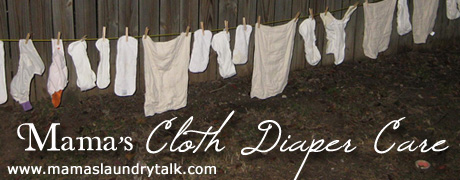
Cloth diapers have made an enormous come back in the last several years. Moms are using cloth diapers to help the environment and especially to save money in their tight budgets. The negative stigma that cloth diapers once held is slowly disappearing.
When I first started with cloth diapers, I was lost. I knew no one else that veered outside of the ‘norm’ of paper diapers. Thankfully, the internet was buzzing with moms that were switching to cloth.
But I was so confused! There were a million diaper types to choose from. So many ways to wash them (Dry pail or wet pail…what?!). So many very basic questions to which I needed some answers.
Over the next couple of weeks, I’ll present a ridiculous amount of cloth diaper information in several posts. Because there is so much to say about cloth diapers (really, there is!), I’m going to write a post on cloth diapers every other week under this same series.
I can’t wait to compile all of this cloth diaper information in one place. It will be so easy for cloth diapering families to find the information they need!
Storing Dirty Diapers
One of the biggest downsides to cloth diapers is the ick factor associated with them. No one wants to deal with bodily fluids, even from a cute little baby. So it is essential to choose the right system in which to store your dirty diapers until wash day.
Wet Pail versus Dry Pail
The first decision in regards to dirty diapers: whether you will store them using a wet-pail system or a dry-pail system.
In a wet-pail system, dirty diapers are placed in a container that is partially filled with water. The water supposedly keeps down the stink of dirty diapers and also helps keep stains from setting in. When transferring dirty diapers from the pail to the washer, you can easily pour the entire contents of the pail into the washing machine. The only time you would touch dirty diapers is when you take them off of the baby and place them in the pail. The two biggest disadvantages to a wet-pail system are:
1) A wet-pail system is extremely hard to use with a front-loading washer. It would be nearly impossible to pour them directly into the washing machine and not spill gross water on the floor. It can be quite messy.
2) A wet-pail system means that there is a pail of water sitting fairly unprotected in the house. Little people can drown in a very small amount of water, including that in a diaper bucket. That being said, there are devices you can use to secure the lid in place. But you would have to be hyper-vigilant to keep that lid intact at all times.
In a dry-pail system, dirty diapers are taken off of the baby and placed in a (dry) container until it is wash day. Unless there is poop that needs to be flushed in the toilet, you can just put them right in the container as-is. No need to un-stuff pocket diapers, since you deal with that on wash day.
Honestly, the dry-pail system is much easier and less messy than the wet-pail method in my opinion. In fact, I don’t know another cloth diapering family that uses the wet-pail. So we are going to focus on the options in setting up a dry-pail method in this post.
Options for Dry-Pail Diaper Storage
Wetbags
Wetbags are a very popular way to store dirty cloth diapers. Wetbags are a literal bag that is sewn using PUL to ensure that the interior is water/poop-proof. Usually there is a pretty cotton fabric sewn on the outside with the PUL layer on the inside. They are sewn using the same PUL fabric that is used to sew the exterior of diapers such as Fuzzi Bunz or BumGenius. Did I mention how unbelievably cute they are? I mean super cute.
How to Use Them:
If your wetbag is large enough, insert it into your diaper pail as you would a trash can liner. If you want to control the stink from the diapers even more, you can close the zippered or drawstring top to the bag each time you use it. Or you can leave it draped over the side of your lidded container.
On wash day, simply put all of your diapers in the machine and toss your wetbag in with the diaper load. Make sure that your wetbag is turned inside out so the interior of the bag is thoroughly washed. Since the bag is probably made from PUL, it is best to let it hang dry.
It’s easier if you have two wetbags – one to put in the diaper pail while the other is washing.
Pros:
Wetbags are very easy to maintain since they go straight in the washer. There are some beautiful bags made by WAHMs, and I love to support them. They conceal diaper stink very well.
Cons:
If you choose to open and close the bag each time, it usually takes two hands to do so – Mamas often only have one hand free. Since it is PUL, the fabric can develop holes or nicks in it, which would cause leaking. They can be pricey.
Lidded Trash Can
How to Use Them:
Lidded Trash Cans can be used with or without a bag inside. If you choose to use a bag, you can use a wetbag, a pail liner or even a trash bag. You can get multiple uses out of a trash bag before you need to replace it. Trash bags are more cost-effective at the outset than a wetbag if you are unsure if you’ll stick with cloth diapering.
If you choose not to use a bag, simply sanitize your container with a disinfecting wipe or a spray cleaner and cloth prior to using it again.
Pros:
The clean-up for a lidded trash clean is minimal, and there is no clean-up if you use a bag other than the occasional wipe down. If you use a lidded trash can that is foot-operated, throwing the diaper in the pail can be totally hands free.
Cons:
If the trash can is deep, it can be hard to clean the bottom effectively. If the lid just sits on top and is not tight-fitting, the room can be smelly.
Plastic Tote Container
Plastic Tote Container refers to any type of lidded organizing container you would buy in the home section of Walmart or Target. Since they come in different sizes, you can customize them to the space in your nursery.
How to Use Them:
Plastic containers are not used with a bag of any type. Diapers are simply taken off of the baby and put straight into the container. When buying a container, ensure that you buy the style in which the lid has hinges on the side. The tighter the lid fits, the less you’ll smell diapers.
Pros:
Plastic Containers are completely customizable to your space. You can buy a larger one for the nursery and a smaller one to keep downstairs. If you buy the hinged lid, there is virtually no detectable diaper smell in the room unless the lid is removed. If you’re going for the incognito look, you can buy a colored container and no one knows your diapers are inside! They are extremely easy to clean by simply sanitizing with a spray cleaner or a disinfecting wipe.
Cons:
They can be bulky when moving them around. It takes two hands to open the hinged lid and throw the diaper inside.
Make sure to follow Mama’s Cloth Diaper Care series on Thursday where I’ll post in-depth instructions on diaper washing routines.
————————————————————————————————
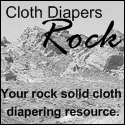 Please visit the sponsor of Mama’s Cloth Diaper Care Series: Cloth Diapers Rock
Please visit the sponsor of Mama’s Cloth Diaper Care Series: Cloth Diapers Rock
Cloth Diapers Rock is a unique cloth diaper matching service. If you need cloth diapers, they’ll match you with a great product and distributor. Cloth Diapers Rock offers information on styles of cloth diapers, sew-your-own diaper tutorials and more!
- 61shares
- Facebook3
- Pinterest24
- Print11
- Twitter9
- Email8

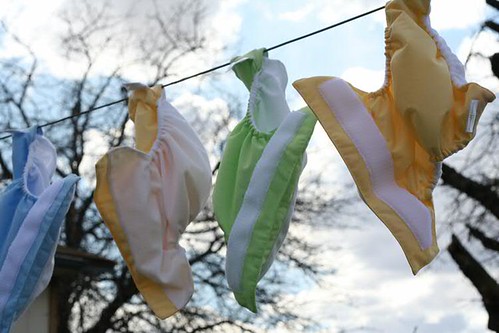
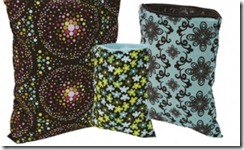
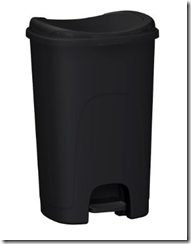

We use a vented plastic hamper for our diaper laundry. It lets air circulate so nothing grows in the humid air of an enclosed container. So glad you are doing some on the cloth diaper laundry. So many people have so many misconceptions on the care of them. I used disposable with child 1 and cloth with child 2 and will never go back to disposable again. It saves so much money and time (from running to the store every time we ran out)
Us, too! It’s just a plain old plastic laundry basket. When it starts to smell – I wash the diapers. 🙂
Ha! Good method 😉 The nose knows, right?
I use a wet bag that fits perfectly into a green waste bin. The bin has a hinged lid that seals very tightly, especially with the bad contributing to the seal. I don’t have any issues with smell.
Then again, I do an initial hand-washing of poopy diapers in the bathroom sink before-hand, so there’s never any poop in the pail. It was icky at first, but I’m not fazed by it anymore, and it really cuts down on any smell.
Dave, I’m so impressed that you wash out diapers prior to putting them in the bin. I have a husband that is not afraid of diapers and it’s so refreshing to see other dads aren’t either.
And you’re totally right – it really helps keep stink at bay.
Thanks for visiting 😉
-Lauren